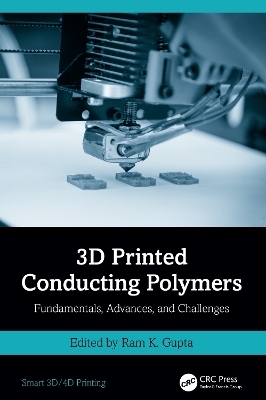
3D Printed Conducting Polymers
CRC Press (Verlag)
978-1-032-54196-9 (ISBN)
Conducting polymers are smart materials that possess unique and tuneable electrical, optical, and electrochemical properties. 3D printing technology is rapidly advancing, and using conducting polymers for this process can lead to many emerging applications as it can print complex structures cost effectively, though many challenges need to be overcome before this technology can be used on a large scale. 3D Printed Conducting Polymers highlights the state of the art of these materials, the basics of additive printing, and the role of conducting polymers in additive manufacturing. It also discusses applications in energy, sensors, and biomedical areas.
Covers fundamentals, synthesis, and various applications of conducting polymers.
Discusses basics of energy devices, sensors, and materials technology for emerging applications.
Explores new approaches for the synthesis of conducting polymers and composites for 3D print technology.
Details future applications and challenges.
Offering direction to researchers and advanced students to better understand the chemistry and electrochemical properties of conducting polymers and technologies for 3D printing, this book advances the science and technology of this emerging field for readers in materials and chemical engineering, biotechnology, energy, and related disciplines.
Ram Gupta is a Professor of Chemistry at Pittsburg State University and Director of Research at the National Institute for Materials Advancement (NIMA). Dr. Gupta’s research focuses on green energy production and storage using conducting polymers and composites, electrocatalysts for fuel cells, nanomaterials, optoelectronic and photovoltaic devices, organic-inorganic hetero-junctions for sensors, nanomagnetism, bio-based polymers, bio-compatible nanofibers for tissue regeneration, scaffold and antibacterial applications, and bio-degradable metallic implants. Dr. Gupta has published over 290 peer-reviewed articles, made over 450 national/international/ regional presentations, chaired many sessions at national/international meetings, edited/written several books/chapters for the American Chemical Society, Royal Society of Chemistry, CRC, Elsevier, Springer, and Wiley. He has received several million dollars for research and educational activities from external agencies. He serves as Associate Editor, Guest Editor, and editorial board member for various journals.
1. 3D Printing: An Introduction. 2. Conducting Polymers: Fundamentals, Synthesis, and Characterizations. 3. Electrochemical Properties of Conducting Polymers. 4. 3D Printed Conducting Polymers for Solar Cells.5. 3D Printed Conducting Polymers for Fuel Cells. 6. 3D Printed Conducting Polymers for Microbial Fuel Cells. 73D Printed Conducting Polymers for Solid Oxide Fuel Cells. 8. 3D Printed Conducting Polymers for Metal-ion Batteries. 9. 3D Printed Conducting Polymers for Metal-sulfur Batteries. 10. 3D Printed Conducting Polymers for Metal-air Batteries. 11. 3D Printed Conducting Polymers for Supercapacitors. 12. 3D Printed Conducting Polymers for Flexible Supercapacitors. 13. 3D Printed Conducting Polymers for Wearable Electronics. 14. 3D Printed Conducting Polymers for Sensors. 15. 3D Printed Conducting Polymers for Biomedical Applications. 16. Challenges and Opportunities of 3D Printing.
| Erscheinungsdatum | 10.07.2024 |
|---|---|
| Reihe/Serie | Smart 3D/4D Printing |
| Zusatzinfo | 44 Line drawings, black and white; 58 Halftones, black and white; 102 Illustrations, black and white |
| Verlagsort | London |
| Sprache | englisch |
| Maße | 156 x 234 mm |
| Gewicht | 825 g |
| Themenwelt | Naturwissenschaften ► Chemie ► Organische Chemie |
| Naturwissenschaften ► Chemie ► Technische Chemie | |
| Technik ► Umwelttechnik / Biotechnologie | |
| ISBN-10 | 1-032-54196-2 / 1032541962 |
| ISBN-13 | 978-1-032-54196-9 / 9781032541969 |
| Zustand | Neuware |
| Informationen gemäß Produktsicherheitsverordnung (GPSR) | |
| Haben Sie eine Frage zum Produkt? |
aus dem Bereich


